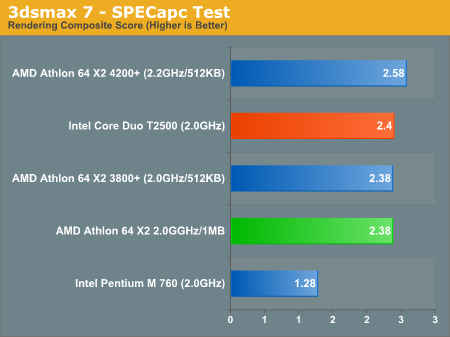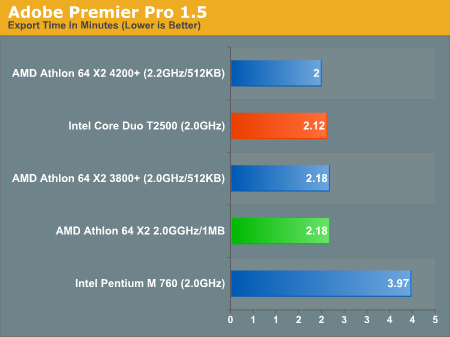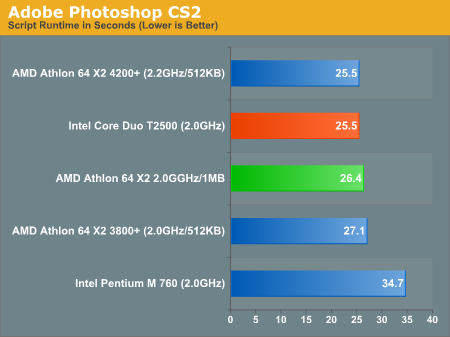Intel Core Duo (Yonah) Performance Preview - Part II
by Anand Lal Shimpi on December 19, 2005 12:55 PM EST- Posted in
- CPUs
Professional Application Performance with 3dsmax, Adobe Premier and Photoshop
We start off our page on professional application performance with an updated version of the SPECapc 3dsmax test, updated for version 7 of the application. The scenes being rendered haven't actually changed, but the reference numbers used to compute the composite scores have, so these scores aren't directly comparable to results from earlier SPECapc tests.
Compared to the Athlon 64 X2, the Core Duo comes out on top, but by a very small margin - once again we're faced with a virtual tie.
The breakdown of the rendering composite score can be found below; the scores in the table are render time in seconds, lower numbers are better:
Moving onto Adobe Premier Pro 1.5, this test is actually one that is used by Intel to showcase the performance of the Pentium 4 processor. With the Pentium 4 absent from this comparison, we were curious as to how it compared to the Core Duo and the Pentium M.
As with virtually any media encoding performance, dual-core processors do extremely well, and this case is no different with the Core Duo T2500 seriously outpacing the Pentium M 760.
The Core Duo T2500 is also able to complete the export process in about 97% of the time of the Athlon 64 X2, which once again ends up being borderline negligible for this test, but it is important to note that this advantage comes without the aid of an on-die memory controller.
Our final test is the only other Intel-supplied test in the suite. This one used to showcase the Pentium 4's performance under Adobe Photoshop CS2 by measuring the time that it takes to run a few filters and resize/export images. The script itself is fairly realistic; however, with Photoshop filters, it is easy to favor one architecture over another, so by no means are these numbers intended to be conclusive of Photoshop CS2 performance.
We start off our page on professional application performance with an updated version of the SPECapc 3dsmax test, updated for version 7 of the application. The scenes being rendered haven't actually changed, but the reference numbers used to compute the composite scores have, so these scores aren't directly comparable to results from earlier SPECapc tests.

Compared to the Athlon 64 X2, the Core Duo comes out on top, but by a very small margin - once again we're faced with a virtual tie.
The breakdown of the rendering composite score can be found below; the scores in the table are render time in seconds, lower numbers are better:
| SPECapc 3dsmax 7 Breakdown | AMD Athlon 64 X2 4200+ | AMD Athlon 64 X2 3800+ | AMD Athlon 64 X2 2.0GHz/1MB | Intel Core Duo T2500 | Intel Pentium M 760 |
| 3dsmax 5 rays | 15.406 | 15.829 | 16.109 | 14.297 | 25.246 |
| CBALLS2 | 20.125 | 22.281 | 22.094 | 21.187 | 42.201 |
| SinglePipe2 | 92.844 | 101.906 | 101.922 | 107.359 | 203.492 |
| UnderWater | 142.938 | 157.219 | 156.203 | 169.188 | 316.055 |
Moving onto Adobe Premier Pro 1.5, this test is actually one that is used by Intel to showcase the performance of the Pentium 4 processor. With the Pentium 4 absent from this comparison, we were curious as to how it compared to the Core Duo and the Pentium M.

As with virtually any media encoding performance, dual-core processors do extremely well, and this case is no different with the Core Duo T2500 seriously outpacing the Pentium M 760.
The Core Duo T2500 is also able to complete the export process in about 97% of the time of the Athlon 64 X2, which once again ends up being borderline negligible for this test, but it is important to note that this advantage comes without the aid of an on-die memory controller.
Our final test is the only other Intel-supplied test in the suite. This one used to showcase the Pentium 4's performance under Adobe Photoshop CS2 by measuring the time that it takes to run a few filters and resize/export images. The script itself is fairly realistic; however, with Photoshop filters, it is easy to favor one architecture over another, so by no means are these numbers intended to be conclusive of Photoshop CS2 performance.

Overall System Performance using WorldBench 5
Media Encoding Performance with DVD Shrink, WME, Quicktime and iTunes










103 Comments
View All Comments
Shintai - Monday, December 19, 2005 - link
I doubt a a laptop uses 108W and got a x800XT. That powerchart is close to useless.A Core Duo laptop is 31 peak for CPU and 2.5 for the 945GM. A single core tution is 35W. unless you want 25W part, but then we gotta use the lower intel part aswell.
Dualcore Turion wont even stand a chance until it get 65nm.
Furen - Tuesday, December 20, 2005 - link
The 25W Turion parts are $5 more expensive than the 35W parts, hardly comparable with the price difference between regular and LV Intel CPUs. I agree with you in that I dont expect 90nm Turions to match Yonah's power consumption but I must say that what I've heard about the Yamato platform (which, to tell the truth, is almost nothing) makes me think that it'll be a closer match than we think.Missing Ghost - Monday, December 19, 2005 - link
What, no 64 bit?I won't buy this.
fitten - Tuesday, December 20, 2005 - link
Do you actually use 64-bit or is it just a feature checkbox? I bought some Athlon64s because they were 64-bit and allowed me to test the software I write on a 64-bit platform, for example... not that the codes I actually write require many of the features of 64-bit, though. In the past, I have written and worked on a number of projects that actually need 64-bit (typically just very large datasets which can just be used flat in 64-bit as opposed to all sorts of tiling and paging on a 32-bit machine).Chickan - Monday, December 19, 2005 - link
Did anyone else notice that the numbers in the graph for Black and White did not match up with the spreadsheet below it? According to the graph, the Core Duo hit 44.5 FPS, the same as the X2 2ghz w/ 1mbx2, but in the sheet below, it is reported to only do 40.1 FPS, lower than even the Pentium M. In fact, it performs the worst out of all the CPU's there, at every resolution, even though this is not reported, nor mentioned.I also find it interesting that Intel's new line is only able to match X2's, not beat them. Either way, lets see some new stuff from AMD!
KazenoKoe - Monday, December 19, 2005 - link
Odd, the article clearly has it at 42.3fps on both the graph and the table. The Pentium M got 40.1 and the X2 2GHz/1MB got 44.5.WitchKing - Monday, December 19, 2005 - link
I enjoyed reading this 2nd article on the next Intel platform.Although I am basically in favor of AMD since Athlon platform, I am quite glad that Intel is closing the performance gap. It will make AMD move further ;-)
Anyway, it should be quite interesting to see how these 2 platforms compare in 64-bits tasks (Windows XP-64, Vista (is a 64-bits version available yet?) and linux based).
A 3rd opus of this article maybe? ;-)
saratoga - Monday, December 19, 2005 - link
Yonah does not support x86-64, so doing 64 bit testing is not possible.phaxmohdem - Monday, December 19, 2005 - link
I thought this review was much better than the first. Thanks guys. It pretty much illustrates the same thing, but it is interesting to read about new CPU's none the less.I don't mind the name personally, I think that we uber-nerds don't like it because we actually know what a core is in regards to a CPU. Your typical idiot customer doesn't know what a Core, or Processor die is, and Core is just another brand name like Pentium.
While these chips look freaking awesome for laptop use, I must admit I will ver very dissapointed it Conroe launches, and only brings Intel back to equality with AMD. When a new generation of CPU launches, I generally like to think that they are releaseing something to regain their status as performance leader, not just level the playing field. (Though I guess PII/PIII/P4 al launched with worse performance than the high end of their predecessors)
tfranzese - Monday, December 19, 2005 - link
If memory serves, the only one to launch with a loss in performance was the Pentium 4. The Pentium II was a great advancement over the Pentium it replaced (not the Pro) and the Pentium III performed equally, though was available at higher clock speeds. That said, I don't know where you got to grouping the PII and PIII in with the P4's poor launch status. Willamette was a joke.